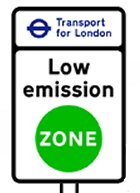Congestion
Charge and Low Emission Zones
| Driving
in London - what's the position? It is not surprising some members have found the present and proposed situation with the London Congestion Charge Zone and London Low Emission Zone puzzling. It is a very confusing subject, not made any easier by all the spin applied by the London Mayor's Office and TfL plus of course there has been a recent election for the post of London Mayor, and a new Mayor, Boris Johnson, has been appointed. The basic position is that there are two entirely separate schemes - the Congestion Charge Zone affecting central London and the Low Emission Zone covering an area of Greater London almost out to the orbital M25 motorway. In this note, Chris Hunt Cooke clarifies the position for members but adds a caution that it is subject to change, so "watch this space!". |
Any views from members on either the London CCZ or LEZ will be welcome on the V8BB. (21.6.08) |
||
| Emissions
Related Congestion Charge Zone The London Congestion Charge was introduced in February 2003, covering an area of central London, and was extended westwards in February 2007. The current charge is a flat £8 a day, subject to certain exemptions and discounts, and operates on weekdays between 7am and 6pm. Regulations have been laid introducing a higher charging band of £25 for certain cars and utility vehicles, with no discounts, with effect from October this year. The vehicles affected are those type approved after 1 March 2001 with CO2 emission figure more than 225 g/km and those type approved before that date with engines of over three litres capacity. Transport for London of TfL has accepted the FBHVC (Federation of British Historic Vehicle Clubs) contention that this means that vehicles over three litres that were never type approved cannot be charged at the higher rate. This is an unintended consequence of the way the regulations were drafted, and TfL have indicated that they intend to introduce a variation order, subject to discussions and consultations. See note on type approval below. Porsche GB is mounting a legal challenge to the £25 proposal, and Boris Johnson, the new Mayor, said prior to his election that he would not introduce that charge, so we shall just have to see what happens over the next few months! |
The
London Low Emissions Zone The Low Emission Zone (LEZ) is now in place, it covers the whole of the Greater London Area or GLA, and is designed to stop the most polluting vehicles entering London at all by imposing a very high charge. It applies to diesel-engined HGVs, buses, coaches, vans, utility vehicles and minibuses that do not meet the required emissions standards. The charges apply 24 hours a day, 365 days a year and are set at a penal level to encourage older commercial vehicles off the roads of London. The important thing for members is that cars (and petrol/lpg vans) are not included. So no MG is therefore affected at all by the LEZ. 
Clarifications provided by FBHVC. (22.6.08) |
||
| Vehicle
type approval As vehicle type approval started in the UK about 1983-85, some seven to nine years after production of the MGBGTV8 model ended at the MG Factory at Abingdon, it is unlikely the model will have been type approved. From a scan of the MGBGTV8 Driver's Handbook AKD 8423 (4th Edition), MGB Workshop Manual AKD 3259 (15th Edition) and MGBGTV8 Workshop Manual Supplement AKD 8468 Issue 2 there is no mention of type approval there. As a doublecheck a request for clarification has been sent to the British Motor Industry Heritage Centre at Gaydon. (22.6.08) |
|||
| Was
the MGBGTV8 ever type approved? - it seems very unlikely The London Congestion Charge was introduced in February 2003, covering an area of central London, and was extended westwards in February 2007. The current charge is a flat £8 a day, subject to certain exemptions and discounts, and operates on weekdays between 7am and 6pm. Regulations have been laid introducing a higher charging band of £25 for certain cars and utility vehicles, with no discounts, with effect from October 2008. The vehicles affected are those type approved after 1 March 2001 with CO2 emission figure more than 225 g/km and those type approved before that date with engines of over three litres capacity. Transport for London of TfL has accepted the FBHVC (Federation of British Historic Vehicle Clubs) contention that this means that vehicles over three litres that were never type approved cannot be charged at the higher rate. This is an unintended consequence of the way the regulations were drafted, and TfL has already indicated that it intends to introduce a variation order to include them, subject to discussions and consultations. Now with a 3.5 litre engine, the MGBGTV8 model would be caught but only if it had been type approved. But has it ever been type approved? That was a question we have tried to clarify. As vehicle type approval started in the UK about 1976, around the time MGBGTV8 production was ending at the MG Factory at Abingdon, it is unlikely the model will have been type approved. I have checked the following documents and can find no mention of type approval for either the MGB or MGBGTV8 models: MGBGTV8 Driver's Handbook AKD 8423 (4th Edition) MGB Workshop Manual AKD 3259 (15th Edition) MGBGTV8 Workshop Manual Supplement AKD 8468 Issue 2 So I contacted BMIHT at Gaydon to see if they have any information or records which might clarify whether the MGBGTV8 model was never type approved? Richard Bacchus at the BMIHT Archive at Gaydon replied: "I'm afraid the build records do not state whether a vehicle has been type approved. I am told that type approval came into being in 1976, with MGBGTV8 production ending in September 1976, so some of the late vehicles could fall into the type approval category." Whether type approval applied as "whole vehicle type approval" in 1976 may in any case be in doubt as Jim Whyman at the FBHVC believes "type approval crept in first with consumables like tyres and did not progress to "whole vehicle type approval" until just over 20 years ago". On reviewing the position Chris Hunt Cooke (a V8 enthusiast with a V8 Roadster and currently the FBHVC chairman) commented: "It is quite extraordinary that the government does not keep records of vehicles it has type-approved, but that does seem to be the position, according to information I found yesterday on the website of the government agency responsible. That agency is the VCA - Vehicle Certification Agency - a new one on me! I found the website after searching for "whole vehicle type approval. One of the VCA FAQ responses below is interesting."
Chris Hunt Cooke comments "The position is far from satisfactory, but I suppose that IF the emissions-related congestion charge does come in (assuming Boris Johnson might have reneged on his election promise) AND at that point TfL has not succeeded in amending its regulations governing it, then the onus will be on TfL to show that the vehicle concerned was type-approved, and then it will come up against this difficulty. It may be that the chairman of the V8 Register should drive his car into central London on the first day of the £25 charge in October 2008 in order to test the system and advise his members!" At around a typical 18mpg in Central London, driving a V8 in congested streets is expensive and certainly not much fun but hopefully a suitable indemnity would be provided by Chris Hunt Cooke for that test! (Victor Smith 24.6.08)
|
|||
|
V8
Register - MG Car Club - the leading group for MG V8 enthusiasts
at www.v8register.net
|
|||


